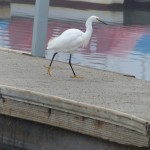The rose-ringed parakeet is a very common parakeet throughout Africa and Asia. In North America, this species has been introduced to California and Florida. This species is named for its pink ring around the neck of this species. In North America, the Indian subspecies manillensis is the type most likely to be seen.
In North America, there are no longer any native species of parrots, sadly. The last native parrot, the Carolina parakeet, died out in 1918. This species was formerly endemic to the eastern US, from Colorado to Florida. It even lived as far north as New York, and was a vagrant to places even further north. It even was recorded in southern Ontario! However, it was hunted for its colorful feathers, which were used to adorn hats. Also, invasive honeybees competed for trees for nesting sites, and this species was regarded as a “menace” and a pest by farmers, due to its behavior of ripping open apples to get at the seeds. This bird also had “funerals, where many parakeets would mourn over the loss of a member of the flock. However, hunters could easily shoot many parakeets in this way, and this resulted in large numbers dying out. By the 1860s to the early 1900s, it became restricted to the swamps of Florida, and soon, it vanished from the wild. The last individual, named “Incas” died in the Cincinnati Zoo in 1918.
After that, the only other North American parrot, the Thick-billed parrot, disappeared from Arizona and New Mexico. Thankfully, that parrot species is still alive, as it is still found in Mexico. It used to appear in areas as far north as Utah, Arizona, New Mexico, and Texas in the US. However, the last individuals in the US died out in 1938.
There are around eight species of feral parrots in North America, with the Rose-ringed parakeet being one of them. Most North American feral parrots are from South America, with a handful of Old World (Europe, Africa, and Asia) parrots also found as escapees.

